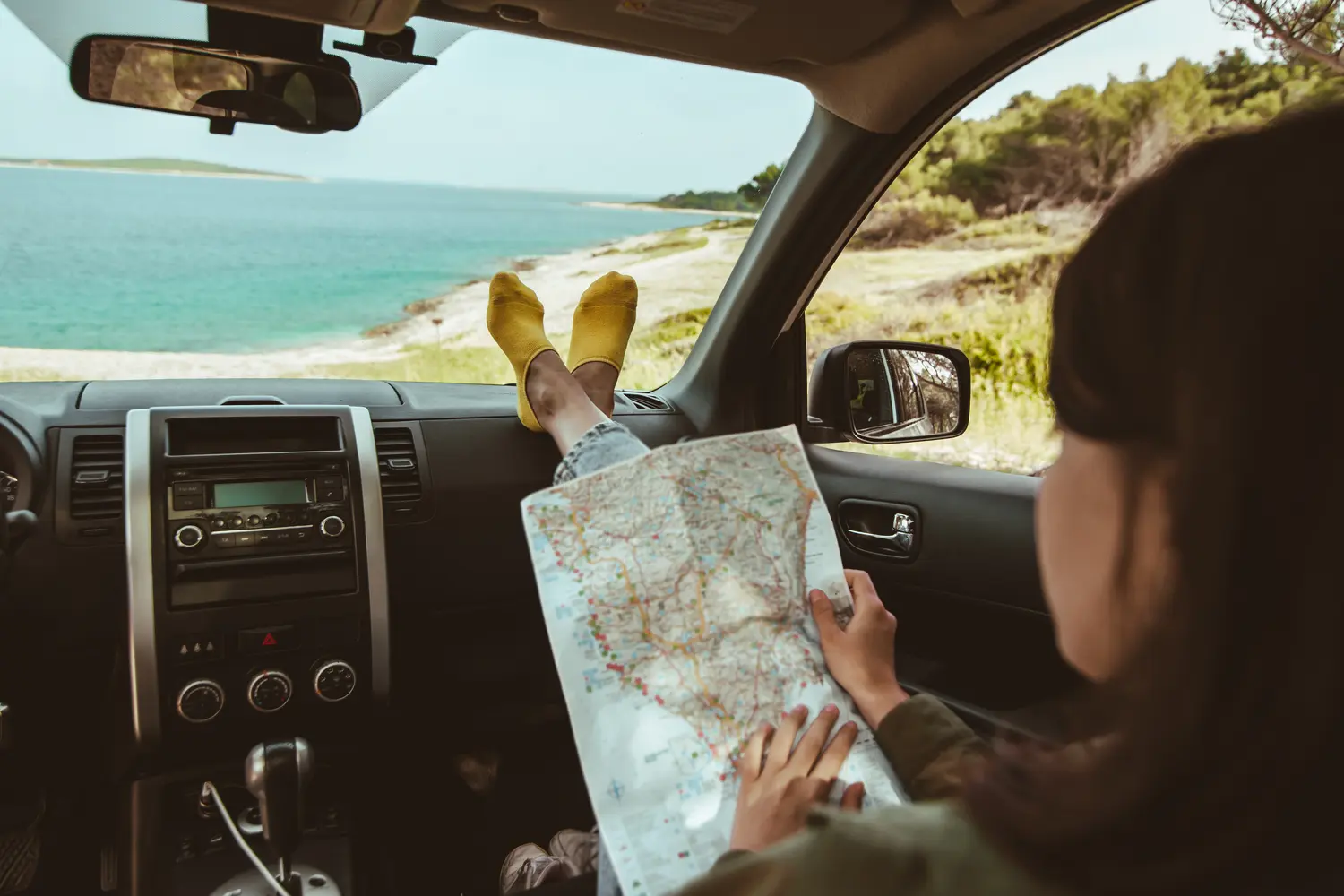Road trips are the golden ticket to exploring the scenic countryside and making core memories, whether you go alone or with friends. The idea of a classic road trip often brings to mind images of sing-along-songs, junk food, and gas station fuel-up stops; however, in today’s world of new technology, it’s time to replace the ladder with charging stations! EV cars are evermore popular and are a great way to explore a country or state while reducing your carbon footprint. But wait, isn’t there a lot of planning when heading out on an electric car road trip? What if the battery runs out? As with every new technology, there are kinks to be worked out. But, EV cars have been around for a few years now and many of the incidents you may have heard about have been noted and resolved. So what does it take to prepare for an EV road trip? We’ll cover all this and more in this guide to planning an electric vehicle road trip! Trust us, it’s easier than you think.
Why Carefully Planning an EV Road Trip is Important
If you’re anything like my mother, you may be fascinated with how these new electric cars work and the difference they make in driving long distances. She is constantly asking friends if they can go on a road trip with their EVs and if it’s hard. Well, it is possible just like with a regular road trip in a gas-powered car. And like a regular road trip, a little bit of planning can help for a smooth journey! I once had a friend of mine spontaneously decide to drive two and a half hours to my cottage for the weekend, but since his electric car wasn’t charged fully the night before, the journey took him two hours longer as he had to hunt down a charging station in the countryside. Now, we aren’t saying you can’t go on spontaneous side-quests and trips with an electric car, it’s just that if he had taken a half hour to map out and find a level three charger (the fastest type of charging station), his journey would have been much faster.
As of July 2023, the Department of Energy found that since the fourth quarter of 2019, the amount of EV chargers in the USA has nearly doubled from 87,352 to 161,562 nationwide. Natural Resources Canada also reported a huge increase in chargers across the country over the past few years, with a total of 10,666 nationwide charging stations along with an investment to bring that number up by 50,000 by 2027. While this means there are more public EV chargers than ever before, it’s still a good idea to plan out your route and include backup charging stations to avoid running out of battery and calling a tow truck.

How to Plan an EV Road Trip
Plan Your Route
The first thing to do when planning an electric car road trip is to map out your route based on the availability of EV charging stations and your estimated mileage. For example, you may want to take the long scenic route through the desert or mountains, but if there aren’t any EV chargers around, you could run the risk of running out of battery. The best way to find EV chargers near you is to use a reliable EV charging station website or app like GRID. We highly recommend giving yourself a 10% battery leniency, meaning don’t let your battery get under 10%!
If you’re new to the EV game, then you should also know there are three types of charging ports. A type one charger is less common but also quite slow. It can take an estimated 50 hours to charge a car battery on this type of station. The most common EV station to find has type two charging ports, which are much faster and can have you fully charged in anywhere from four to 10 hours. Type three, or DC chargers, are the crème de la crème of stations and can have road trippers charged up and ready to fly back on the highway in as little as 20 minutes. It’s never a guarantee that an EV charger will be available (especially in the summertime), so always have a backup station in mind if the lot is full!
It’s also a good idea to plan some sort of activity while charging. For example, you could grab a bite to eat or charge near a shopping mall and go for a wander. Alternatively, you could recharge in nature while letting your car recharge at a national park. According to the National Parks Conservation Association, 27 national parks across the USA offer around 100 EV charging stations.
Plan Your Accommodation
You must choose accommodation that offers EV chargers, otherwise, you’ll be wasting precious daylight hours charging your car instead of cruising the highway. If you’re planning on hunkering down for the night in a hotel, we highly recommend using Booking.com to sort through options as the website allows you to filter results based on hotels with EV chargers on site. Those looking to rent a vacation home on the road should do so through Airbnb as the website also allows you to filter homes by EV chargers.
Another great option that may not have come to mind is to camp and stay at an RV campground. RV chargers are the exact same as type two chargers, so travelers on a budget could plug in for the night while tent camping on their site or sleeping in the car!
Understand Your EV Car
Whether you own an electric vehicle or you’re looking at renting one, you’re going to want to understand the capabilities of the car. For example, Teslas need a special adapter to use non-Tesla charging stations. You’ll want to confirm what charging cord comes with the EV so you know what kind of charging type is supported (i.e., Type two or type three DC). Not all public charging stations offer cords, so always carry one in the trunk of the vehicle just in case. Those renting a car will also want to look out for vehicles that are known for their long-range battery life. The Tesla Model 3, the Nissan Ariya, and the Chevy Silverado EV are all excellent choices for long-distance journeys as they can easily put over 300 miles to a charge! The average driving range on electric cars is around 250-350 miles. Other factors to consider when choosing an EV car are the trunk and passenger space. If you need to haul lots of camping gear, then a mid-size SUV might be more practical, like the Chevrolet Blazer EV.
Maximize Battery Efficiency
While electrical cars have a good battery life, some factors could impact the battery life. You’ll want to keep these in mind when you’re mapping out your route so that your battery doesn’t get below 10% without a charge. Firstly, cold weather plays a factor in your battery life, as just like with other batteries and gas-powered cars, the cold drains them quicker than normal. In fact, temperatures under 20 Fahrenheit decrease the vehicle’s range by 12% according to a study done by AAA. So keep this in mind if you’re looking at the upcoming weather forecast. Secondly, how much weight you have in the car will make an impact on battery life. By packing light with just the essentials, you’ll be able to maximize your battery life on the road.
It’s also always a good idea to check your tires before hitting the road. The same goes for gas-powered cars, but with EVs, low tire pressure can make a huge impact on battery life and mileage. So grab that pressure gauge and give it a quick go-over before leaving! The last thing to remember is the efficiency of the vehicle. If you are constantly changing speeds, using air conditioning/heating, accelerating fast, or driving at high speeds, then the battery will drain quickly. To maximize your EV’s battery life, use cruise control and, if possible, use climate control as little as possible and drive around 50 mph as this is an optimal speed for battery life. If you can, avoid using the roof rack as well as the drag can lower the battery efficiency by 25%.

What to Pack and Useful Apps for an EV Road Trip
There are a few essentials you’ll want to double-check you have before taking a road trip in an electric car. First and foremost, you will want to double-check that you have charging cords and adapters so that you can access all charging stations with ease. Also, ensure you have your trusty EV charging station app or website, like GRID, PlugShare, or A Better Route Planner (ABRP) on hand or with screenshots so that you won’t be aimlessly driving around trying to find a station or free spot. It’s also a good idea to download the official apps for the charging stations as the credit card readers don’t always work. If you sign up for a membership with the official charging app, you can usually pay through your phone and track your charging progress while shopping or grabbing dinner. Some of the charging stations you’ll see in the USA are Electrify America, EVgo, Blink, Semacharge, and Charge Point.
Now that you’re an expert on charging electric cars on the road and how to prepare for an EV road trip, all you have to do now is hit the highway! For ideas on what to pack for a long-haul road trip, like gadgets, organization, and entertainment for the whole family, check out our list of road trip essentials to pack!
Comments